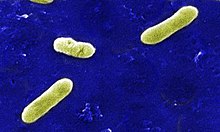| Bordetella bronchiseptica | |
|---|---|

| |
| Scanning electron micrograph of B. bronchiseptica | |
| Scientific classification | |
| Domain: | Bacteria |
| Phylum: | Pseudomonadota |
| Class: | Betaproteobacteria |
| Order: | Burkholderiales |
| Family: | Alcaligenaceae |
| Genus: | Bordetella |
| Species: | B. bronchiseptica |
| Binomial name | |
| Bordetella bronchiseptica (Ferry 1912) Moreno-López 1952 | |
Bordetella bronchiseptica is a small, gram-negative, rod-shaped bacterium of the genus Bordetella. It can cause infectious bronchitis in dogs and other animals, but rarely infects humans. Closely related to B. pertussis—the obligate human pathogen that causes pertussis (whooping cough); B. bronchiseptica can persist in the environment for extended periods.
Pathogenesis
Humans are not natural carriers of B. bronchiseptica, which typically infects the respiratory tracts of smaller mammals (cats, dogs, rabbits, etc.). People are more likely to be infected by B. pertussis or B. parapertussis. Unlike B. pertussis, B. bronchiseptica is generally resistant to macrolide antibiotics. It is also generally resistant to cephalosporins. Some human cases have been successfully treated with trimethoprim/sulfamethoxazole and fluoroquinolones.
B. bronchiseptica does not express pertussis toxin, which is one of the characteristic virulence factors of B. pertussis, but it has the genes to do so, highlighting the close evolutionary relationship between the two species.
Veterinary pathogenesis

In veterinary medicine, B. bronchiseptica leads to a range of pathologies in different hosts. It is a serious disease of dogs, pigs, and rabbits, and has been seen in cats, horses, and seals. A PCR test for the pathogen exists.
In pigs, B. bronchiseptica and Pasteurella multocida act synergistically to cause atrophic rhinitis, a disease resulting in arrested growth and distortion of the turbinates in the nasal terminus (snout). In dogs, B. bronchiseptica causes acute tracheobronchitis, which typically has a harsh, honking cough. Kennel cough can also be caused by canine adenovirus-2 or canine parainfluenza virus or a combination of pathogens.
In rabbits, B. bronchiseptica is often found in the nasal tract. It is often assumed to cause a nearly asymptomatic infection known as snuffles, but the causative agent for that disease is Pasteurella multocida; B. bronchiseptica often co-infects the nasal passage at the same time.
Cats infected with B. bronchiseptica have been seen with tracheobronchitis, conjunctivitis, and rhinitis (upper respiratory tract infection - URI), mandibular lymphadenopathy, and pneumonia. However, URI in cats can also be caused by herpesvirus, calicivirus, Mycoplasma species, or Chlamydia psittaci. An intranasal vaccine exists for cats.
Outbreaks
2022 outbreak
In late 2022, together with the H3N2 strain of canine influenza and other respiratory pathogens, Bordetella bronchiseptica experienced a surge in canine infections. This was partially due to increased human travel and reopened offices following the relaxation of COVID-19 pandemic public health measures, leading to large numbers of dogs being placed together in kennels and doggy day care centers. Changing pet ownership behaviors also led to overcrowded animal shelters,after the pandemic.
References
- Hewlett, EL (1995). "Bordetella species." In: Principles and Practice of Infectious Diseases (Mandel, GL, Bennett, JE, Dolin, R, eds.). Churchill Livingston, Inc., New York, NY. pp. 2078–2084.
- Pedro-Pons, Agustín (1968). Patología y Clínica Médicas (in Spanish). Vol. 6 (3rd ed.). Barcelona: Salvat. p. 613. ISBN 978-84-345-1106-4.
- Ryan KJ; Ray CG, eds. (2004). Sherris Medical Microbiology (4th ed.). McGraw Hill. ISBN 978-0-8385-8529-0.
- ^ Finger H, von Koenig CHW (1996). Bordetella. In: Barron's Medical Microbiology (Barron S et al., eds.) (4th ed.). Univ of Texas Medical Branch. ISBN 978-0-9631172-1-2. (via NCBI Bookshelf).
- Coote JG (2001). "Environmental sensing mechanisms in Bordetella". Adv Microb Physiol. Advances in Microbial Physiology. 44: 141–81. doi:10.1016/S0065-2911(01)44013-6. ISBN 9780120277445. PMID 11407112.
- Mattoo S, Foreman-Wykert AK, Cotter PA, Miller JF (2001). "Mechanisms of Bordetella pathogenesis". Front Biosci. 6: E168–86. doi:10.2741/Mattoo. PMID 11689354.
- Diavatopoulos DA, Cummings CA, Schouls LM, Brinig MM, Relman DA, Mooi FR (2005). "Bordetella pertussis, the Causative Agent of Whooping Cough, Evolved from a Distinct, Human-Associated Lineage of B. bronchiseptica". PLOS Pathog. 1 (4): e45. doi:10.1371/journal.ppat.0010045. PMC 1323478. PMID 16389302.
- ^ "Bordetella data sheet". Zoologix. Retrieved 2009-03-08.
- Lawhorn, Bruce. "Atrophic Rhinitis" (PDF). Texas Agricultural Extension Service. L-2193. Archived from the original (PDF) on 2017-08-04. Retrieved 2017-07-23.
- Wagener, J. S., R. Sobonya, L. Minnich and L. M. Taussig (1984). Role of canine parainfluenza virus and Bordetella bronchiseptica in kennel cough. Am J Vet Res 45(9): 1862-6.
- Burns, E. H., Jr., J. M. Norman, M. D. Hatcher and D. A. Bemis (1993). Fimbriae and determination of host species specificity of Bordetella bronchiseptica. J Clin Microbiol 31(7): 1838-44
- "Prevention and control of Bordetella bronchiseptica infection in cats". Intervet/Schering-Plough Animal Health. Retrieved 2009-03-08.
- Anthes, Emily (2 December 2022). "Dog Flu Is Back, Too". New York Times. Archived from the original on 17 December 2022. Retrieved 17 December 2022.
External links
| Classification | D |
|---|
- Material Safety Data Sheet (MSDS) for Bordetella bronchiseptica (Public Health Agency of Canada)
- Genetic sequences of the Bordetella bronchiseptica complex (Sanger Institute)
- Type strain of Bordetella bronchiseptica at BacDive - the Bacterial Diversity Metadatabase
| Taxon identifiers | |
|---|---|
| Bordetella bronchiseptica | |